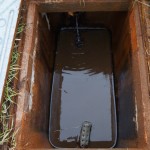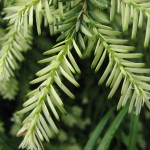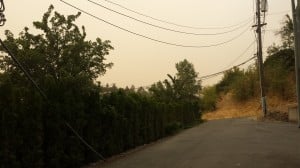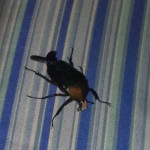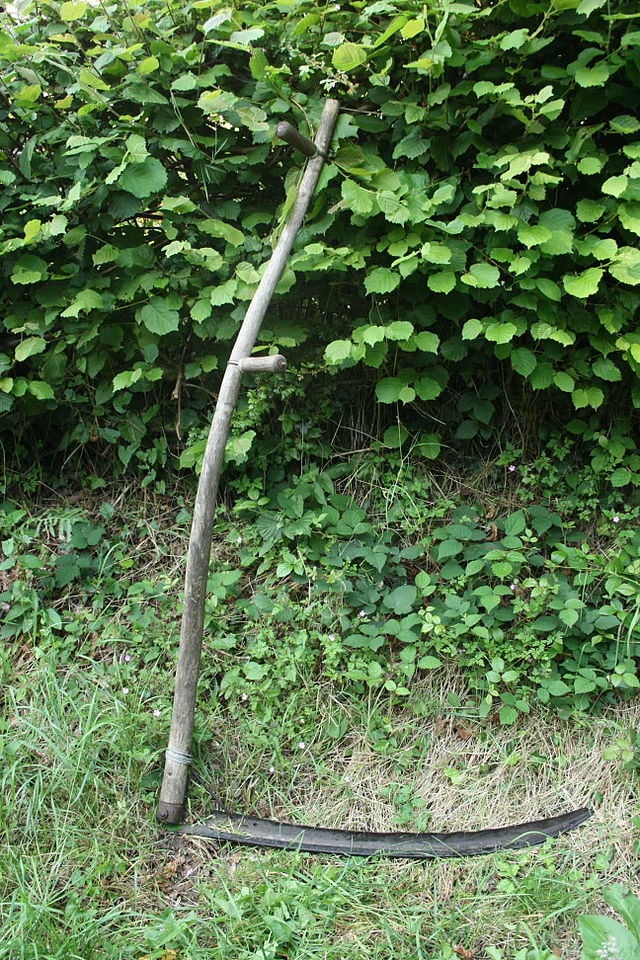
It’s not that I don’t like these plants. Quite the contrary. I love the plants that most people call weeds. But that’s not the point. The point is that the landlord has been complaining that the lawn isn’t mowed and it looks “untidy”. We need to fix it, and that means that someone has to go get a lawnmower. I’m not all that fond of gas powered lawnmowers, but a scythe, well that’s a worthy instrument to take the lives of these fair plants.
Since mid 2000 I’ve had a secret love of scythes. I have a not-so-secret love of blades in general. I like knives. I seriously dig swords. Someday I’m going to find a teacher and learn proper swordsmanship. Because SWORDS. But my love of scythes isn’t in the usual bucket of blade love.
It all started with the book Building a Low Impact Roundhouse that I picked up in the editors’ review pile when I worked at Amazon. That book put me on a journey of discovery about owner built housing and off-grid living. That journey also led me to the discovery of low impact tools for home and garden. This is how I discovered the idea of the scythe as a lawnmower. Ever since, I’ve figured that if I ever had a lawn to mow, this is how I’d want to do it.
So, on Friday as I sat there dreaming of scything the yard and contemplated ordering a scythe online, it dawned on me that it was Lammas/Loughnassadh. This time of Harvest and Life is also a time of Death. The symbol of the scythe represents the harvest that gives us bread, but it also symbolizes Death itself and conjures up mental images of the black cloaked figure of folklore and popular culture. The death of the grain grasses is what gives us life. These two things cannot be separated from each other.
Death is not an end of things. Death is change. We say that a lot in different streams of Paganism, but how much do we know it in our flesh? Death is scary. Needless Death is terrible. And yet, Death is a constant companion. We eat it every day.
Suddenly I notice that Death isn’t the worst thing in the world. Waste is. Needless Death isn’t just change, it’s wasted Life. And that thought lingers on my mind for a while, turning through a hundred permutations. Rotten vegetables in the refrigerator. Wasted opportunities. War. These aren’t equal, but they are all Death in the negative sense. They are all a loss of possibility, the squandering of life and blessings.
The Hooded Figure With A Scythe is not a squanderer of opportunities. It is silent and sharp and efficient. It kills and gives life in a single motion. An animal dies and billions of micro-organisms get a feast. Maybe a few larger organisms, too. And what of the possibilities inherent in the life of the thing before it died? Except for humans and the friends of humans, we generally don’t think of such a thing at all. What opportunities have been lost by a mouse that is caught and eaten by a wolf?
You cannot build a home without destroying something in the process. Trees for the wood. Stones taken from their long rest in the Earth. Straw for bales that build walls. Mud dug up to make bricks, leaving a hole where the ground was once whole. That is a kind of Death, too.
My dreams for the life I’m trying to build are given birth and killed from moment to moment as the sands around me shift.
My hosts got a free lawnmower off Craigslist. I won’t be buying a scythe today. But someday I may.

